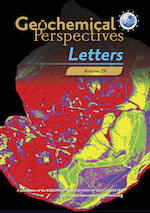How long for plastics to decompose in the deep sea?
Affiliations | Corresponding Author | Cite as | Funding information- Share this article





-
Article views:299Cumulative count of HTML views and PDF downloads.
- Download Citation
- Rights & Permissions
top
Abstract
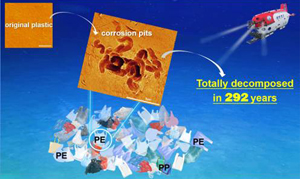
Figures
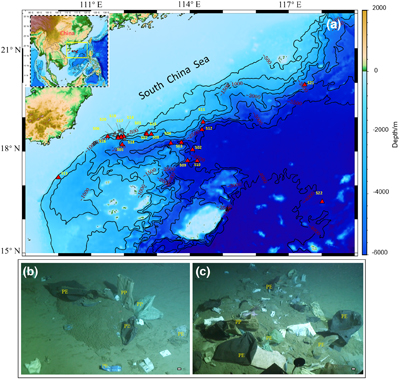 Figure 1 (a) Sampling sites of plastic litter in the northern South China Sea (Table S-1 lists detailed information of sampling locations; red triangles refer to the sampling sites). (b) Plastic bags, woven bags, and packing bags accumulated on the seafloor of site S06. (c) Various types of plastics with different colours accumulated on the seafloor of site S14. PE: polyethylene, PP: polypropylene, scale bar = 10 cm. | 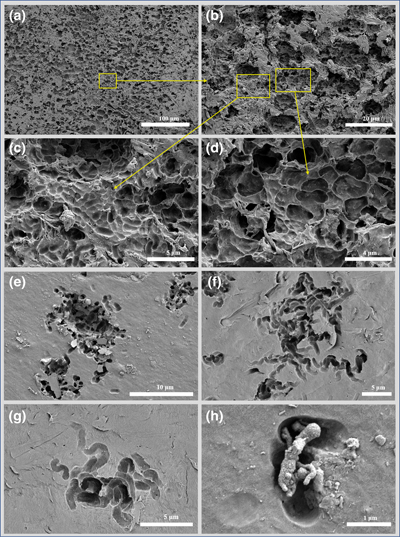 Figure 2 Typical examples of SEM images of PE samples with corrosion pits. (a) SEM photomicrographs of partial surface of P102. (b) Enlarged image of the yellow line marked area in a. (c, d) Enlarged image of the yellow line marked area in b. (e, f, g) SEM images of different corrosion pits observed on the surface of P27, P19 and P18. (h) Objects with microbial morphologies on the surface of pits of P103. | 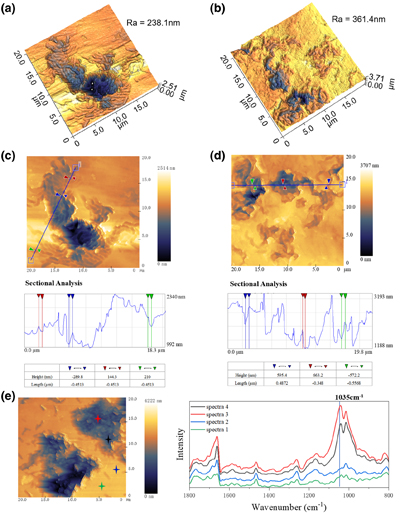 Figure 3 Typical examples of PiFM images, spectra, and sectional analysis of PE with corrosion pits. (a, b) 3D images of worm-like structures. Ra represents roughness average. (c, d) 2D images and the cross sectional analysis along the line. (e) PiFM images and spectra corresponding to inside of corrosion pits (spectra 3, 4) and outside of pits (spectra 1, 2). | 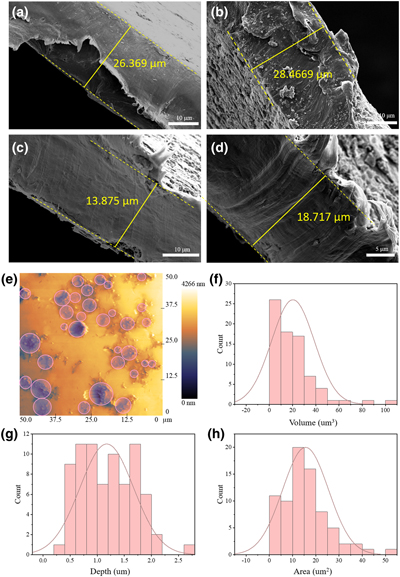 Figure 4 (a, b, c, d) Examples of SEM images of thickness of PE samples with corrosion pits. (e) PiFM image of P102. The circles in red were pits at least 1 μm wide and 0.1 μm deep. (f, g, h) Histogram of the depth, area and volume of corrosion pits of P102 measured by PiFM. |
| Figure 1 | Figure 2 | Figure 3 | Figure 4 |
top
Introduction
Marine plastic pollution is a major environmental problem affecting human health and ocean ecosystems (Lebreton et al., 2017
Lebreton, L., Van Der Zwet, J., Damsteeg, J.W., Slat, B., Andrady, A., Reisser, J. (2017) River plastic emissions to the world’s oceans. Nature Communications 8, 1–10. https://doi.org/10.1038/ncomms15611
). It has been estimated that around 15 million metric tons of plastic debris reach the oceans annually (Jambeck et al., 2015Jambeck, J.R., Geyer, R., Wilcox, C., Siegler, T.R., Perryman, M., Andrady, A., Narayan, R., Law, K.L. (2015) Plastic waste inputs from land into the ocean. Science 347, 768–771. https://doi.org/10.1126/science.1260352
), of which 70 % will sink to seafloor (Thompson et al., 2004Thompson, R.C., Olsen, Y., Mitchell, R.P., Davis, A., Rowland, S.J., John, A.W., McGonigle, D., Russell, A.E. (2004) Lost at sea: where is all the plastic? Science 304, 838. https://doi.org/10.1126/science.1094559
) and are eventually transported to the deep sea floor (Bergmann et al., 2017Bergmann, M., Wirzberger, V., Krumpen, T., Lorenz, C., Primpke, S., Tekman, M.B., Gerdts, G. (2017) High quantities of microplastic in Arctic deep-sea sediments from the HAUSGARTEN observatory. Environmental Science & Technology 51, 11000–11010. https://doi.org/10.1021/acs.est.7b03331
; Zhong and Peng, 2021Zhong, G., Peng, X. (2021) Transport and accumulation of plastic litter in submarine canyons—The role of gravity flows. Geology 49, 581–586. https://doi.org/10.1130/G48536.1
). Complexity and high costs of sampling in the deep sea environments lead to limited recognition of deep sea plastics and restrict understanding of their final fate, although a few studies show that plastic might be ubiquitous at the deep sea floor (Peng et al., 2018Peng, X., Cheng, M., Chen, S., Dasgupta, S., Xu, H., Ta, K., Du, M., Guo, Z., Bai, S. (2018) Microplastics contaminate the deepest part of the world’s ocean. Geochemical Perspectives Letters 9, 1–5. https://doi.org/10.7185/geochemlet.1829
, 2019Peng, X., Dasgupta, S., Zhong, G., Du, M., Xu, H., Chen, M., Chen, S., Ta, K., Li, J. (2019) Large debris dumps in the northern South China Sea. Marine Pollution Bulletin 142, 164–168. https://doi.org/10.1016/j.marpolbul.2019.03.041
; Nakajima et al., 2021Nakajima, R., Tsuchiya, M., Yabuki, A., Masuda, S., Kitahashi, T., Nagano, Y., Ikuta, T., Isobe, N., Nakata, H., Ritchie, H., Oguri, K., Osafune, S., Kawamura, K., Suzukawa, M., Yamauchi, T., Iijima, K., Yoshida, T., Chiba, S., Fujikura, K. (2021) Massive occurrence of benthic plastic debris at the abyssal seafloor beneath the Kuroshio Extension, the North West Pacific. Marine Pollution Bulletin 166, 112188. https://doi.org/10.1016/j.marpolbul.2021.112188
).It is generally considered that most plastics are quite recalcitrant to degradation and may persist several hundred years or even longer (Chamas et al., 2020
Chamas, A., Moon, H., Zheng, J., Qiu, Y., Tabassum, T., Jang, J.H., Abu-Omar, M., Scott, S.L., Suh, S. (2020) Degradation rates of plastics in the environment. ACS Sustainable Chemistry & Engineering 8, 3494–3511. https://doi.org/10.1021/acssuschemeng.9b06635
), although so far there is no available data on the actual retention times of plastics in various natural environments (Ter Halle et al., 2017Ter Halle, A., Ladirat, L., Martignac, M., Mingotaud, A.F., Boyron, O., Perez, E. (2017) To what extent are microplastics from the open ocean weathered? Environmental Pollution 227, 167–174. https://doi.org/10.1016/j.envpol.2017.04.051
; Turner et al., 2020Turner, A., Arnold, R., Williams, T. (2020) Weathering and persistence of plastic in the marine environment: Lessons from LEGO. Environmental Pollution 262, 114299. https://doi.org/10.1016/j.envpol.2020.114299
). The degradation of plastic litter in ocean surfaces and beaches, including photo-oxidative, thermal, mechanical, and biodegradation are well recorded (Corcoran et al., 2009Corcoran, P.L., Biesinger, M.C., Grifi, M. (2009) Plastics and beaches: a degrading relationship. Marine Pollution Bulletin 58, 80–84. https://doi.org/10.1016/j.marpolbul.2008.08.022
; Masry et al., 2021Masry, M., Rossignol, S., Gardette, J.L., Therias, S., Bussière, P.O., Wong-Wah-Chung, P. (2021) Characteristics, fate, and impact of marine plastic debris exposed to sunlight: A review. Marine Pollution Bulletin 171, 112701. https://doi.org/10.1016/j.marpolbul.2021.112701
), but it has never been reported in the deep sea where the environment differs from that of the shallow water because of the relatively low temperature, absence of UV light and depleted oxygen (Chamas et al., 2021Chamas, A., Moon, H., Zheng, J., Qiu, Y., Tabassum, T., Jang, J.H., Abu-Omar, M., Scott, S.L., Suh, S. (2020) Degradation rates of plastics in the environment. ACS Sustainable Chemistry & Engineering 8, 3494–3511. https://doi.org/10.1021/acssuschemeng.9b06635
). Those factors in deep sea environments can inhibit the thermal and photo-oxidative degradation of plastic litter (Nakajima et al., 2021Nakajima, R., Tsuchiya, M., Yabuki, A., Masuda, S., Kitahashi, T., Nagano, Y., Ikuta, T., Isobe, N., Nakata, H., Ritchie, H., Oguri, K., Osafune, S., Kawamura, K., Suzukawa, M., Yamauchi, T., Iijima, K., Yoshida, T., Chiba, S., Fujikura, K. (2021) Massive occurrence of benthic plastic debris at the abyssal seafloor beneath the Kuroshio Extension, the North West Pacific. Marine Pollution Bulletin 166, 112188. https://doi.org/10.1016/j.marpolbul.2021.112188
). Consequently, biodegradation might be the most important form of plastic degradation in deep sea. Previous studies showed that the surface of deep sea plastics could supply additional habitats and relevant sources of carbon for colonisation of microbes, along with potentially evolving microorganisms that can degrade plastics (Wright et al., 2020Wright, R.J., Erni-Cassola, G., Zadjelovic, V., Latva, M., Christie-Oleza, J.A. (2020) Marine plastic debris: a new surface for microbial colonization. Environmental Science & Technology 54, 11657–11672. https://doi.org/10.1021/acs.est.0c02305
; Wang et al., 2021Wang, J., Peng, C., Li, H., Zhang, P., Liu, X. (2021) The impact of microplastic-microbe interactions on animal health and biogeochemical cycles: a mini-review. Science of The Total Environment 773, 145697. https://doi.org/10.1016/j.scitotenv.2021.145697
). However, it still remains unknown whether the deep sea plastics could be degraded by microbes and how long the plastics can persist in deep sea.top
Characterisation of Plastics in the Deep Sea
A total of 103 pieces of plastics (Fig. S-1) were recovered from the deep sea floor (746–3997 m) of the northern South China Sea (SCS) using manipulators during 22 dives with the manned submersible Shenhaiyongshi (Table S-1, Fig. 1). According to the Raman spectrum (Fig. S-2), the most abundant samples were identified as PE (80 %) and PP (14 %), followed by polyethylene terephthalate (PET, 2 %), polyvinyl chloride (PVC, 2 %), polystyrene (PS, 1 %) and polyesters (Pe, 1 %). Detailed information of plastic samples is listed in Table S-2. Different compositions of plastic samples were observed to have different morphological features on their surfaces. Most of the PE samples showed characteristics of degradation including crumples, grooves, scratches, flakes, cracks, and irregular pits (Fig. S-3). The degradation of the plastic samples was confirmed on the basis of the occurrence of C=O (1659 cm−1), C-O (1032 cm−1) and O-H (3300-3500 cm−1) bonds by Fourier Transform Infrared (FTIR) analysis (Fig. S-3g) (Bhagwat et al., 2021
Bhagwat, G., Carbery, M., Anh Tran, T.K., Grainge, I., O’Connor, W., Palanisami, T. (2021) Fingerprinting Plastic-Associated Inorganic and Organic Matter on Plastic Aged in the Marine Environment for a Decade. Environmental Science & Technology 55, 7407–7417. https://doi.org/10.1021/acs.est.1c00262
). In the case of PP (Fig. S-4), surface cracking was apparent in most items from the deep sea, also typically observed in the PP collected from the coastal and offshore environment (Rizzo et al., 2021Rizzo, M., Corbau, C., Lane, B., Malkin, S.Y., Bezzi, V., Vaccaro, C., Nardin, W. (2021) Examining the dependence of macroplastic fragmentation on coastal processes (Chesapeake Bay, Maryland). Marine Pollution Bulletin 169, 112510. https://doi.org/10.1016/j.marpolbul.2021.112510
). Degradation via crack formation is considered the common degraded pattern of PP, which is possibly caused by photo-oxidation when they were in shallow water (Song et al., 2017Song, Y.K., Hong, S.H., Jang, M., Han, G.M., Jung, S.W., Shim, W.J. (2017) Combined effects of UV exposure duration and mechanical abrasion on microplastic fragmentation by polymer type. Environmental Science & Technology 51, 4368–4376. https://doi.org/10.1021/acs.est.6b06155
; Tang et al., 2019Tang, C.C., Chen, H.I., Brimblecombe, P., Lee, C.L. (2019) Morphology and chemical properties of polypropylene pellets degraded in simulated terrestrial and marine environments. Marine Pollution Bulletin 149, 110626. https://doi.org/10.1016/j.marpolbul.2019.110626
). While other plastics, such as PET, PS, PVC and Pe (Fig. S-5), exhibited rather smooth surfaces with only visible physical scratches.
Figure 1 (a) Sampling sites of plastic litter in the northern South China Sea (Table S-1 lists detailed information of sampling locations; red triangles refer to the sampling sites). (b) Plastic bags, woven bags, and packing bags accumulated on the seafloor of site S06. (c) Various types of plastics with different colours accumulated on the seafloor of site S14. PE: polyethylene, PP: polypropylene, scale bar = 10 cm.
top
Degradation on the Surface of PE
Especially intriguing were numerous corrosion pits found on the surface of eighteen PE debris (Fig. 2a–g). The plastic surface showed a high degree of degradation, which was pockmarked with abundant pits linked to each other (Fig. 2a,b). Two structures of corrosion pits, including short rod-like and peanut-like structures, were distributed and overlapped on the surface of plastics (Fig. 2c,d). In addition, other forms of pits were also observed on PE surfaces, such as worm-like and filamentous structures (Fig. 2e–g). All pits are 1-2 μm in length and their morphologies just coincide with those of some bacteria.

Figure 2 Typical examples of SEM images of PE samples with corrosion pits. (a) SEM photomicrographs of partial surface of P102. (b) Enlarged image of the yellow line marked area in a. (c, d) Enlarged image of the yellow line marked area in b. (e, f, g) SEM images of different corrosion pits observed on the surface of P27, P19 and P18. (h) Objects with microbial morphologies on the surface of pits of P103.
The three dimensional morphology by photo-induced force microscopy (PiFM) showed the typical worm-like structures (Fig. 3a,b). The Ra (Roughness Average) value is usually used to indicate surface roughness. It is evident that the more heavily degraded plastic exhibits higher roughness. PiFM can be used to probe the micron scale topography of pits to higher accuracy and precision in the vertical dimension compared to the Scanning Electron Microscope (SEM). Through the cross sectional analysis of PiFM images, the worm-like pits are approximately 0.9 μm in width (0.45 × 2 μm) and 144.3–289.8 nm in depth in the relatively early stages of degradation (Fig. 3c). As degradation progresses, the pit depths become deeper, up to about 572.2–663.2 nm deep (Fig. 3d).

Figure 3 Typical examples of PiFM images, spectra, and sectional analysis of PE with corrosion pits. (a, b) 3D images of worm-like structures. Ra represents roughness average. (c, d) 2D images and the cross sectional analysis along the line. (e) PiFM images and spectra corresponding to inside of corrosion pits (spectra 3, 4) and outside of pits (spectra 1, 2).
A peak at 1035 cm−1 in PiFM spectrum was distinctly identified on the surface of pits, attributed to -C-O- bond stretching characteristic of ethers, carboxylic acids and esters (Andrady et al., 2022
Andrady, A.L., Law, K.L., Donohue, J., Koongolla, B. (2022) Accelerated degradation of low-density polyethylene in air and in sea water. Science of The Total Environment 811, 151368. https://doi.org/10.1016/j.scitotenv.2021.151368
). This feature of spectra was consistent with those from laboratory experiments of microbial degradation (Puglisi et al., 2019Puglisi, E., Romaniello, F., Galletti, S., Boccaleri, E., Frache, A., Cocconcelli, P.S. (2019) Selective bacterial colonization processes on polyethylene waste samples in an abandoned landfill site. Scientific Reports 9, 1–13. https://doi.org/10.1038/s41598-019-50740-w
; Khandare et al., 2021Khandare, S.D., Chaudhary, D.R., Jha, B. (2021) Marine bacterial biodegradation of low-density polyethylene (LDPE) plastic. Biodegradation 32, 127–143. https://doi.org/10.1007/s10532-021-09927-0
). In addition, the corrosion pits found in this study highly resemble those from previous laboratory experiments which show similar corrosion pits are produced by microbes during biodegradation of plastics (Yoshida et al., 2016Yoshida, S., Hiraga, K., Takehana, T., Taniguchi, I., Yamaji, H., Maeda, Y., Toyohara, K., Miyamoto, K., Kimura, Y., Oda, K. (2016) A bacterium that degrades and assimilates poly (ethylene terephthalate). Science 351, 1196–1199. https://doi.org/10.1126/science.aad6359
; Puglisi et al., 2019Puglisi, E., Romaniello, F., Galletti, S., Boccaleri, E., Frache, A., Cocconcelli, P.S. (2019) Selective bacterial colonization processes on polyethylene waste samples in an abandoned landfill site. Scientific Reports 9, 1–13. https://doi.org/10.1038/s41598-019-50740-w
), further suggesting a biological origin. Furthermore, surfaces of PE stained using SYBR green I showed that rod-like cells were densely present on the surface of pits (Fig. S-7a,b), together with the objects with microbial morphologies observed by SEM (Fig. 2h), also corroborating evidence suggesting that the formation of corrosion pits is potentially caused by microbial degradation.Only a few studies on the surface characteristics of plastics sinking into the deep sea naturally have been performed due to sampling difficulties. Krause et al. (2020)
Krause, S., Molari, M., Gorb, E.V., Gorb, S.N., Kossel, E., Haeckel, M. (2020) Persistence of plastic debris and its colonization by bacterial communities after two decades on the abyssal seafloor. Scientific Reports 10, 1–15. https://doi.org/10.1038/s41598-020-66361-7
found only two bulk plastic bags of PE at a water depth of 4150 m during the ROV dives. Nevertheless, the two items showed no apparent sign of biological degradation, possibly due to the short residence time after they reached the seafloor. While in our study, the unique pits suggestive of a biodegradation activity were found for the first time on the surface of plastics on the deep sea floor. This suggests that microbial degradation could happen more easily than chemical degradation in extreme conditions of the deep ocean that is characterised by lower temperatures, absence of UV light and lower oxygen concentration than in the shallow sea, although the biodegradation speed of plastics in deep sea is relatively low. Currently, the roles of enzymes in plastic biodegradation have been highlighted in several studies, including microbial depolymerases, hydrolases, lipases, and peroxidases (Roohi et al., 2017Roohi, Bano, K., Kuddus, M., Zaheer, M.R., Zia, Q., Khan, M.F., Gupta, A.Md., Aliev, G. (2017) Microbial enzymatic degradation of biodegradable plastics. Current Pharmaceutical Biotechnology 18, 429–440. https://doi.org/10.2174/1389201018666170523165742
; Amobonye et al., 2021Amobonye, A., Bhagwat, P., Singh, S., Pillai, S. (2021) Plastic biodegradation: Frontline microbes and their enzymes. Science of The Total Environment 759, 143536. https://doi.org/10.1016/j.scitotenv.2020.143536
). Widely present pits on the surface of PE may also suggest that cold-adapted enzymes produced by barophilic/tolerant microorganisms and psychrophiles possibly play important roles in degrading plastics in the deep sea (Urbanek et al., 2018Urbanek, A.K., Rymowicz, W., Mirończuk, A.M. (2018) Degradation of plastics and plastic-degrading bacteria in cold marine habitats. Applied Microbiology and Biotechnology 102, 7669–7678. https://doi.org/10.1007/s00253-018-9195-y
; Atanasova et al., 2021Atanasova, N., Stoitsova, S., Paunova-Krasteva, T., Kambourova, M. (2021). Plastic degradation by extremophilic bacteria. International Journal of Molecular Sciences 22, 5610. https://doi.org/10.3390/ijms22115610
).top
Quantification of Degradation of PE
We used the volume loss to quantify the degradation of PE plastics at the deep sea floor. According to SEM images of cross sections (Fig. 4a–d), the thicknesses of the eighteen PE samples with corrosion pits in our study ranged from 13.236–28.467 μm. The pit density and the depth, mouth area, volume of individual pits were analysed from the PiFM images. The statistical results are tabulated in Table S-3. As shown in Figures 4e and S-6, all the pits at least 1 μm wide and 0.1 μm deep on the surface of P102 were counted and the depths of these pits were analysed by SurfaceWorks (Molecular Vista, Inc.). The statistical results showed that the depth, mouth area, and volume of corrosion pits on the surface of plastic (P102) are 1.733 μm, 24.11 μm2, 35.67 μm3 respectively (Fig. 4f–h). Using the calculated volume ratio of corroded pits and plastics, we could estimate that about 1.08–13.72 % of a piece of polyethylene plastic on the deep sea floor might be degraded.

Figure 4 (a, b, c, d) Examples of SEM images of thickness of PE samples with corrosion pits. (e) PiFM image of P102. The circles in red were pits at least 1 μm wide and 0.1 μm deep. (f, g, h) Histogram of the depth, area and volume of corrosion pits of P102 measured by PiFM.
So far, there are no appropriate ways to date large plastics that are deposited into the oceans because these materials have only been manufactured over a relatively short period of time (several decades) and there is a lack of sedimentary sequences (Turner et al., 2020
Turner, A., Arnold, R., Williams, T. (2020) Weathering and persistence of plastic in the marine environment: Lessons from LEGO. Environmental Pollution 262, 114299. https://doi.org/10.1016/j.envpol.2020.114299
). Some studies about plastic persistence and deposition ages of plastic show they are, according to the outer packing, from a distinct temporal source (Ioakeimidis et al., 2016Ioakeimidis, C., Fotopoulou, K.N., Karapanagioti, H.K., Geraga, M., Zeri, C., Papathanassiou, E., Galgani, F., Papatheodorou, G. (2016) The degradation potential of PET bottles in the marine environment: An ATR-FTIR based approach. Scientific Reports 6, 1–8. https://doi.org/10.1038/srep23501
; Krause et al., 2020Krause, S., Molari, M., Gorb, E.V., Gorb, S.N., Kossel, E., Haeckel, M. (2020) Persistence of plastic debris and its colonization by bacterial communities after two decades on the abyssal seafloor. Scientific Reports 10, 1–15. https://doi.org/10.1038/s41598-020-66361-7
). However, there is no information available on the date of manufacture of our plastic samples. In order to constrain the deposition ages of plastics, we use the dating data of microplastic pollution in the same research area of the South China Sea, which show microplastic pollution in this area commenced in the 1980s and has a forty year pollution history (Chen et al., 2020Chen, M., Du, M., Jin, A., Chen, S., Dasgupta, S., Li, J., Xu, H., Ta, K., Peng, X. (2020) Forty-year pollution history of microplastics in the largest marginal sea of the western Pacific. Geochemical Perspectives Letters 13, 42–47. https://doi.org/10.7185/geochemlet.2012
). Assuming that the most degraded plastics in our samples have already been at the deep sea floor for 40 years, it would take about 292 years for these plastics to be fully degraded. This result provides the upper limitation for the degradation time of PE in deep sea and represents the maximum degradation time for these deep sea plastics.top
Conclusions and Implications
The fate of plastics in marine environments is a matter that is still in debate. Some have argued that all the conventional plastics entering oceans have never been degraded and still remain either as whole items or as fragments to date (Barnes et al., 2009
Barnes, D.K., Galgani, F., Thompson, R.C., Barlaz, M. (2009) Accumulation and fragmentation of plastic debris in global environments. Philosophical Transactions of the Royal Society B: Biological Sciences 364, 1985–1998. https://doi.org/10.1098/rstb.2008.0205
). This study provides the first evidence that plastics in the deep sea can be degraded, and estimates that the maximum residence time of PE is about 292 years, although there exist some uncertainties regarding the dating of plastics. In addition, the mere presence of corrosion pits on PE suggests other types of plastics, such as PP, PET, PVC and PS, will persist on the deep sea floor for a far longer period of time, and could have more profound and lasting threats to the deep sea ecosystem. Strict control measures should be taken to prevent these refractory plastics from entering the oceans.top
Acknowledgements
We thank the crews and scientists of R/V Tansuoyihao and pilots of HOV Shenghaiyongshi in the voyages (TS07, TS12, TS16, TS2-1-3). This work was supported by National Key Research and Development Plan of China (2016YFC0302301).
Editor: Eric H. Oelkers
top
References
Amobonye, A., Bhagwat, P., Singh, S., Pillai, S. (2021) Plastic biodegradation: Frontline microbes and their enzymes. Science of The Total Environment 759, 143536. https://doi.org/10.1016/j.scitotenv.2020.143536
 Show in context
Show in context Currently, the roles of enzymes in plastic biodegradation have been highlighted in several studies, including microbial depolymerases, hydrolases, lipases, and peroxidases (Roohi et al., 2017; Amobonye et al., 2021).
View in article
Andrady, A.L., Law, K.L., Donohue, J., Koongolla, B. (2022) Accelerated degradation of low-density polyethylene in air and in sea water. Science of The Total Environment 811, 151368. https://doi.org/10.1016/j.scitotenv.2021.151368
 Show in context
Show in context A peak at 1035 cm−1 in PiFM spectrum was distinctly identified on the surface of pits, attributed to -C-O- bond stretching characteristic of ethers, carboxylic acids and esters (Andrady et al., 2022).
View in article
Atanasova, N., Stoitsova, S., Paunova-Krasteva, T., Kambourova, M. (2021). Plastic degradation by extremophilic bacteria. International Journal of Molecular Sciences 22, 5610. https://doi.org/10.3390/ijms22115610
 Show in context
Show in context Widely present pits on the surface of PE may also suggest that cold-adapted enzymes produced by barophilic/tolerant microorganisms and psychrophiles possibly play important roles in degrading plastics in the deep sea (Urbanek et al., 2018; Atanasova et al., 2021).
View in article
Barnes, D.K., Galgani, F., Thompson, R.C., Barlaz, M. (2009) Accumulation and fragmentation of plastic debris in global environments. Philosophical Transactions of the Royal Society B: Biological Sciences 364, 1985–1998. https://doi.org/10.1098/rstb.2008.0205
 Show in context
Show in context Some have argued that all the conventional plastics entering oceans have never been degraded and still remain either as whole items or as fragments to date (Barnes et al., 2009).
View in article
Bergmann, M., Wirzberger, V., Krumpen, T., Lorenz, C., Primpke, S., Tekman, M.B., Gerdts, G. (2017) High quantities of microplastic in Arctic deep-sea sediments from the HAUSGARTEN observatory. Environmental Science & Technology 51, 11000–11010. https://doi.org/10.1021/acs.est.7b03331
 Show in context
Show in context It has been estimated that around 15 million metric tons of plastic debris reach the oceans annually (Jambeck et al., 2015), of which 70 % will sink to seafloor (Thompson et al., 2004) and are eventually transported to the deep sea floor (Bergmann et al., 2017; Zhong and Peng, 2021).
View in article
Bhagwat, G., Carbery, M., Anh Tran, T.K., Grainge, I., O’Connor, W., Palanisami, T. (2021) Fingerprinting Plastic-Associated Inorganic and Organic Matter on Plastic Aged in the Marine Environment for a Decade. Environmental Science & Technology 55, 7407–7417. https://doi.org/10.1021/acs.est.1c00262
 Show in context
Show in context The degradation of the plastic samples was confirmed on the basis of the occurrence of C=O (1659 cm−1), C-O (1032 cm−1) and O-H (3300-3500 cm−1) bonds by Fourier Transform Infrared (FTIR) analysis (Fig. S-3g) (Bhagwat et al., 2021).
View in article
Chamas, A., Moon, H., Zheng, J., Qiu, Y., Tabassum, T., Jang, J.H., Abu-Omar, M., Scott, S.L., Suh, S. (2020) Degradation rates of plastics in the environment. ACS Sustainable Chemistry & Engineering 8, 3494–3511. https://doi.org/10.1021/acssuschemeng.9b06635
 Show in context
Show in context It is generally considered that most plastics are quite recalcitrant to degradation and may persist several hundred years or even longer (Chamas et al., 2020), although so far there is no available data on the actual retention times of plastics in various natural environments (Ter Halle et al., 2017; Turner et al., 2020).
View in article
The degradation of plastic litter in ocean surfaces and beaches, including photo-oxidative, thermal, mechanical, and biodegradation are well recorded (Corcoran et al., 2009; Masry et al., 2021), but it has never been reported in the deep sea where the environment differs from that of the shallow water because of the relatively low temperature, absence of UV light and depleted oxygen (Chamas et al., 2021).
View in article
Chen, M., Du, M., Jin, A., Chen, S., Dasgupta, S., Li, J., Xu, H., Ta, K., Peng, X. (2020) Forty-year pollution history of microplastics in the largest marginal sea of the western Pacific. Geochemical Perspectives Letters 13, 42–47. https://doi.org/10.7185/geochemlet.2012
 Show in context
Show in context In order to constrain the deposition ages of plastics, we use the dating data of microplastic pollution in the same research area of the South China Sea, which show microplastic pollution in this area commenced in the 1980s and has a forty year pollution history (Chen et al., 2020).
View in article
Corcoran, P.L., Biesinger, M.C., Grifi, M. (2009) Plastics and beaches: a degrading relationship. Marine Pollution Bulletin 58, 80–84. https://doi.org/10.1016/j.marpolbul.2008.08.022
 Show in context
Show in context The degradation of plastic litter in ocean surfaces and beaches, including photo-oxidative, thermal, mechanical, and biodegradation are well recorded (Corcoran et al., 2009; Masry et al., 2021), but it has never been reported in the deep sea where the environment differs from that of the shallow water because of the relatively low temperature, absence of UV light and depleted oxygen (Chamas et al., 2021).
View in article
Ioakeimidis, C., Fotopoulou, K.N., Karapanagioti, H.K., Geraga, M., Zeri, C., Papathanassiou, E., Galgani, F., Papatheodorou, G. (2016) The degradation potential of PET bottles in the marine environment: An ATR-FTIR based approach. Scientific Reports 6, 1–8. https://doi.org/10.1038/srep23501
 Show in context
Show in context Some studies about plastic persistence and deposition ages of plastic show they are, according to the outer packing, from a distinct temporal source (Ioakeimidis et al., 2016; Krause et al., 2020).
View in article
Jambeck, J.R., Geyer, R., Wilcox, C., Siegler, T.R., Perryman, M., Andrady, A., Narayan, R., Law, K.L. (2015) Plastic waste inputs from land into the ocean. Science 347, 768–771. https://doi.org/10.1126/science.1260352
 Show in context
Show in context It has been estimated that around 15 million metric tons of plastic debris reach the oceans annually (Jambeck et al., 2015), of which 70 % will sink to seafloor (Thompson et al., 2004) and are eventually transported to the deep sea floor (Bergmann et al., 2017; Zhong and Peng, 2021).
View in article
Khandare, S.D., Chaudhary, D.R., Jha, B. (2021) Marine bacterial biodegradation of low-density polyethylene (LDPE) plastic. Biodegradation 32, 127–143. https://doi.org/10.1007/s10532-021-09927-0
 Show in context
Show in context This feature of spectra was consistent with those from laboratory experiments of microbial degradation (Puglisi et al., 2019; Khandare et al., 2021).
View in article
Krause, S., Molari, M., Gorb, E.V., Gorb, S.N., Kossel, E., Haeckel, M. (2020) Persistence of plastic debris and its colonization by bacterial communities after two decades on the abyssal seafloor. Scientific Reports 10, 1–15. https://doi.org/10.1038/s41598-020-66361-7
 Show in context
Show in context Krause et al. (2020) found only two bulk plastic bags of PE at a water depth of 4150 m during the ROV dives.
View in article
Some studies about plastic persistence and deposition ages of plastic show they are, according to the outer packing, from a distinct temporal source (Ioakeimidis et al., 2016; Krause et al., 2020).
View in article
Lebreton, L., Van Der Zwet, J., Damsteeg, J.W., Slat, B., Andrady, A., Reisser, J. (2017) River plastic emissions to the world’s oceans. Nature Communications 8, 1–10. https://doi.org/10.1038/ncomms15611
 Show in context
Show in context Marine plastic pollution is a major environmental problem affecting human health and ocean ecosystems (Lebreton et al., 2017).
View in article
Masry, M., Rossignol, S., Gardette, J.L., Therias, S., Bussière, P.O., Wong-Wah-Chung, P. (2021) Characteristics, fate, and impact of marine plastic debris exposed to sunlight: A review. Marine Pollution Bulletin 171, 112701. https://doi.org/10.1016/j.marpolbul.2021.112701
 Show in context
Show in context The degradation of plastic litter in ocean surfaces and beaches, including photo-oxidative, thermal, mechanical, and biodegradation are well recorded (Corcoran et al., 2009; Masry et al., 2021), but it has never been reported in the deep sea where the environment differs from that of the shallow water because of the relatively low temperature, absence of UV light and depleted oxygen (Chamas et al., 2021).
View in article
Nakajima, R., Tsuchiya, M., Yabuki, A., Masuda, S., Kitahashi, T., Nagano, Y., Ikuta, T., Isobe, N., Nakata, H., Ritchie, H., Oguri, K., Osafune, S., Kawamura, K., Suzukawa, M., Yamauchi, T., Iijima, K., Yoshida, T., Chiba, S., Fujikura, K. (2021) Massive occurrence of benthic plastic debris at the abyssal seafloor beneath the Kuroshio Extension, the North West Pacific. Marine Pollution Bulletin 166, 112188. https://doi.org/10.1016/j.marpolbul.2021.112188
 Show in context
Show in context Complexity and high costs of sampling in the deep sea environments lead to limited recognition of deep sea plastics and restrict understanding of their final fate, although a few studies show that plastic might be ubiquitous at the deep sea floor (Peng et al., 2018, 2019; Nakajima et al., 2021).
View in article
Those factors in deep sea environments can inhibit the thermal and photo-oxidative degradation of plastic litter (Nakajima et al., 2021).
View in article
Peng, X., Cheng, M., Chen, S., Dasgupta, S., Xu, H., Ta, K., Du, M., Guo, Z., Bai, S. (2018) Microplastics contaminate the deepest part of the world’s ocean. Geochemical Perspectives Letters 9, 1–5. https://doi.org/10.7185/geochemlet.1829
 Show in context
Show in context Complexity and high costs of sampling in the deep sea environments lead to limited recognition of deep sea plastics and restrict understanding of their final fate, although a few studies show that plastic might be ubiquitous at the deep sea floor (Peng et al., 2018, 2019; Nakajima et al., 2021).
View in article
Peng, X., Dasgupta, S., Zhong, G., Du, M., Xu, H., Chen, M., Chen, S., Ta, K., Li, J. (2019) Large debris dumps in the northern South China Sea. Marine Pollution Bulletin 142, 164–168. https://doi.org/10.1016/j.marpolbul.2019.03.041
 Show in context
Show in context Complexity and high costs of sampling in the deep sea environments lead to limited recognition of deep sea plastics and restrict understanding of their final fate, although a few studies show that plastic might be ubiquitous at the deep sea floor (Peng et al., 2018, 2019; Nakajima et al., 2021).
View in article
Puglisi, E., Romaniello, F., Galletti, S., Boccaleri, E., Frache, A., Cocconcelli, P.S. (2019) Selective bacterial colonization processes on polyethylene waste samples in an abandoned landfill site. Scientific Reports 9, 1–13. https://doi.org/10.1038/s41598-019-50740-w
 Show in context
Show in context This feature of spectra was consistent with those from laboratory experiments of microbial degradation (Puglisi et al., 2019; Khandare et al., 2021).
View in article
In addition, the corrosion pits found in this study highly resemble those from previous laboratory experiments which show similar corrosion pits are produced by microbes during biodegradation of plastics (Yoshida et al., 2016; Puglisi et al., 2019), further suggesting a biological origin.
View in article
Rizzo, M., Corbau, C., Lane, B., Malkin, S.Y., Bezzi, V., Vaccaro, C., Nardin, W. (2021) Examining the dependence of macroplastic fragmentation on coastal processes (Chesapeake Bay, Maryland). Marine Pollution Bulletin 169, 112510. https://doi.org/10.1016/j.marpolbul.2021.112510
 Show in context
Show in context In the case of PP (Fig. S-4), surface cracking was apparent in most items from the deep sea, also typically observed in the PP collected from the coastal and offshore environment (Rizzo et al., 2021).
View in article
Roohi, Bano, K., Kuddus, M., Zaheer, M.R., Zia, Q., Khan, M.F., Gupta, A.Md., Aliev, G. (2017) Microbial enzymatic degradation of biodegradable plastics. Current Pharmaceutical Biotechnology 18, 429–440. https://doi.org/10.2174/1389201018666170523165742
 Show in context
Show in context Currently, the roles of enzymes in plastic biodegradation have been highlighted in several studies, including microbial depolymerases, hydrolases, lipases, and peroxidases (Roohi et al., 2017; Amobonye et al., 2021).
View in article
Song, Y.K., Hong, S.H., Jang, M., Han, G.M., Jung, S.W., Shim, W.J. (2017) Combined effects of UV exposure duration and mechanical abrasion on microplastic fragmentation by polymer type. Environmental Science & Technology 51, 4368–4376. https://doi.org/10.1021/acs.est.6b06155
 Show in context
Show in context Degradation via crack formation is considered the common degraded pattern of PP, which is possibly caused by photo-oxidation when they were in shallow water (Song et al., 2017; Tang et al., 2019).
View in article
Tang, C.C., Chen, H.I., Brimblecombe, P., Lee, C.L. (2019) Morphology and chemical properties of polypropylene pellets degraded in simulated terrestrial and marine environments. Marine Pollution Bulletin 149, 110626. https://doi.org/10.1016/j.marpolbul.2019.110626
 Show in context
Show in context Degradation via crack formation is considered the common degraded pattern of PP, which is possibly caused by photo-oxidation when they were in shallow water (Song et al., 2017; Tang et al., 2019).
View in article
Ter Halle, A., Ladirat, L., Martignac, M., Mingotaud, A.F., Boyron, O., Perez, E. (2017) To what extent are microplastics from the open ocean weathered? Environmental Pollution 227, 167–174. https://doi.org/10.1016/j.envpol.2017.04.051
 Show in context
Show in context It is generally considered that most plastics are quite recalcitrant to degradation and may persist several hundred years or even longer (Chamas et al., 2020), although so far there is no available data on the actual retention times of plastics in various natural environments (Ter Halle et al., 2017; Turner et al., 2020).
View in article
Thompson, R.C., Olsen, Y., Mitchell, R.P., Davis, A., Rowland, S.J., John, A.W., McGonigle, D., Russell, A.E. (2004) Lost at sea: where is all the plastic? Science 304, 838. https://doi.org/10.1126/science.1094559
 Show in context
Show in context It has been estimated that around 15 million metric tons of plastic debris reach the oceans annually (Jambeck et al., 2015), of which 70 % will sink to seafloor (Thompson et al., 2004) and are eventually transported to the deep sea floor (Bergmann et al., 2017; Zhong and Peng, 2021).
View in article
Turner, A., Arnold, R., Williams, T. (2020) Weathering and persistence of plastic in the marine environment: Lessons from LEGO. Environmental Pollution 262, 114299. https://doi.org/10.1016/j.envpol.2020.114299
 Show in context
Show in context It is generally considered that most plastics are quite recalcitrant to degradation and may persist several hundred years or even longer (Chamas et al., 2020), although so far there is no available data on the actual retention times of plastics in various natural environments (Ter Halle et al., 2017; Turner et al., 2020).
View in article
So far, there are no appropriate ways to date large plastics that are deposited into the oceans because these materials have only been manufactured over a relatively short period of time (several decades) and there is a lack of sedimentary sequences (Turner et al., 2020).
View in article
Urbanek, A.K., Rymowicz, W., Mirończuk, A.M. (2018) Degradation of plastics and plastic-degrading bacteria in cold marine habitats. Applied Microbiology and Biotechnology 102, 7669–7678. https://doi.org/10.1007/s00253-018-9195-y
 Show in context
Show in context Widely present pits on the surface of PE may also suggest that cold-adapted enzymes produced by barophilic/tolerant microorganisms and psychrophiles possibly play important roles in degrading plastics in the deep sea (Urbanek et al., 2018; Atanasova et al., 2021).
View in article
Wang, J., Peng, C., Li, H., Zhang, P., Liu, X. (2021) The impact of microplastic-microbe interactions on animal health and biogeochemical cycles: a mini-review. Science of The Total Environment 773, 145697. https://doi.org/10.1016/j.scitotenv.2021.145697
 Show in context
Show in context Previous studies showed that the surface of deep sea plastics could supply additional habitats and relevant sources of carbon for colonisation of microbes, along with potentially evolving microorganisms that can degrade plastics (Wright et al., 2020; Wang et al., 2021).
View in article
Wright, R.J., Erni-Cassola, G., Zadjelovic, V., Latva, M., Christie-Oleza, J.A. (2020) Marine plastic debris: a new surface for microbial colonization. Environmental Science & Technology 54, 11657–11672. https://doi.org/10.1021/acs.est.0c02305
 Show in context
Show in context Previous studies showed that the surface of deep sea plastics could supply additional habitats and relevant sources of carbon for colonisation of microbes, along with potentially evolving microorganisms that can degrade plastics (Wright et al., 2020; Wang et al., 2021).
View in article
Yoshida, S., Hiraga, K., Takehana, T., Taniguchi, I., Yamaji, H., Maeda, Y., Toyohara, K., Miyamoto, K., Kimura, Y., Oda, K. (2016) A bacterium that degrades and assimilates poly (ethylene terephthalate). Science 351, 1196–1199. https://doi.org/10.1126/science.aad6359
 Show in context
Show in context In addition, the corrosion pits found in this study highly resemble those from previous laboratory experiments which show similar corrosion pits are produced by microbes during biodegradation of plastics (Yoshida et al., 2016; Puglisi et al., 2019), further suggesting a biological origin.
View in article
Zhong, G., Peng, X. (2021) Transport and accumulation of plastic litter in submarine canyons—The role of gravity flows. Geology 49, 581–586. https://doi.org/10.1130/G48536.1
 Show in context
Show in context It has been estimated that around 15 million metric tons of plastic debris reach the oceans annually (Jambeck et al., 2015), of which 70 % will sink to seafloor (Thompson et al., 2004) and are eventually transported to the deep sea floor (Bergmann et al., 2017; Zhong and Peng, 2021).
View in article
top
Supplementary Information
The Supplementary Information includes:
- Material and Methods
- Tables S-1 to S-3
- Figures S-1 to S-7
- Supplementary Information References
Download the Supplementary Information (PDF).
Figures
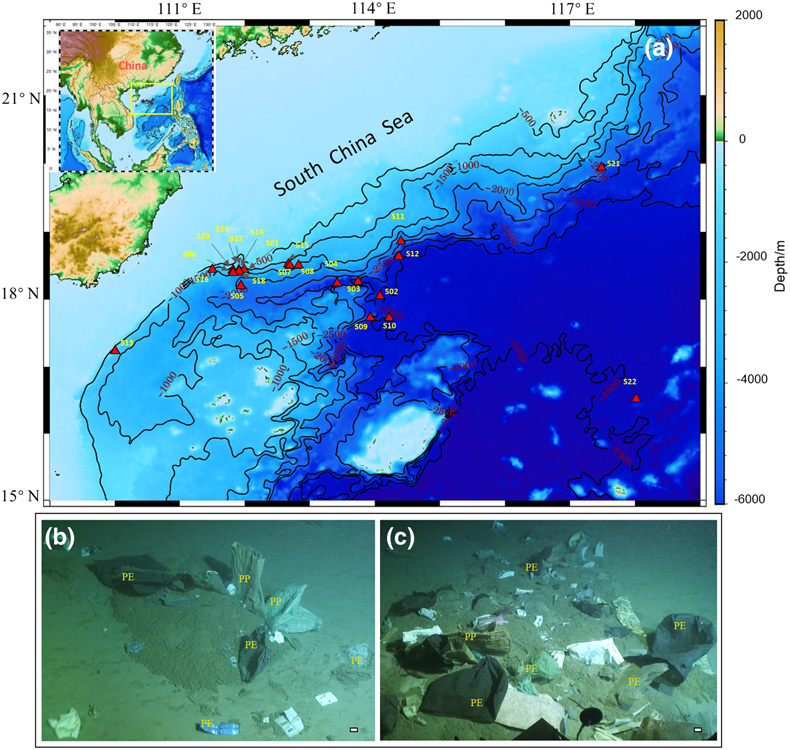
Figure 1 (a) Sampling sites of plastic litter in the northern South China Sea (Table S-1 lists detailed information of sampling locations; red triangles refer to the sampling sites). (b) Plastic bags, woven bags, and packing bags accumulated on the seafloor of site S06. (c) Various types of plastics with different colours accumulated on the seafloor of site S14. PE: polyethylene, PP: polypropylene, scale bar = 10 cm.
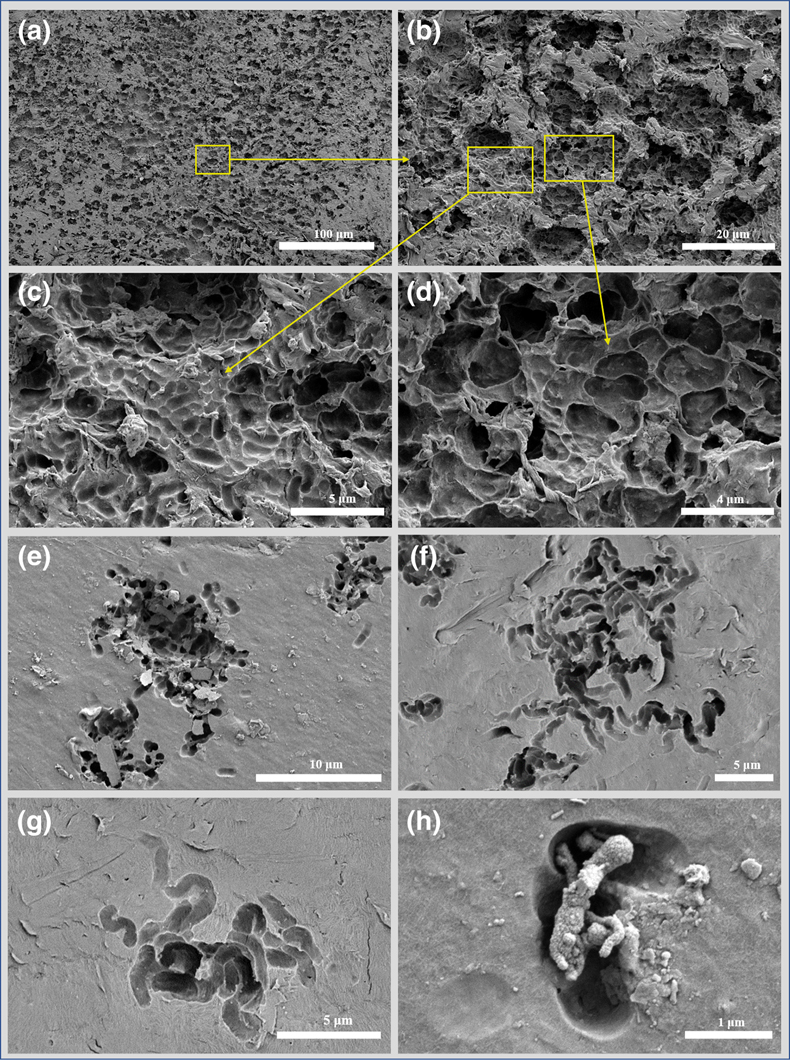
Figure 2 Typical examples of SEM images of PE samples with corrosion pits. (a) SEM photomicrographs of partial surface of P102. (b) Enlarged image of the yellow line marked area in a. (c, d) Enlarged image of the yellow line marked area in b. (e, f, g) SEM images of different corrosion pits observed on the surface of P27, P19 and P18. (h) Objects with microbial morphologies on the surface of pits of P103.
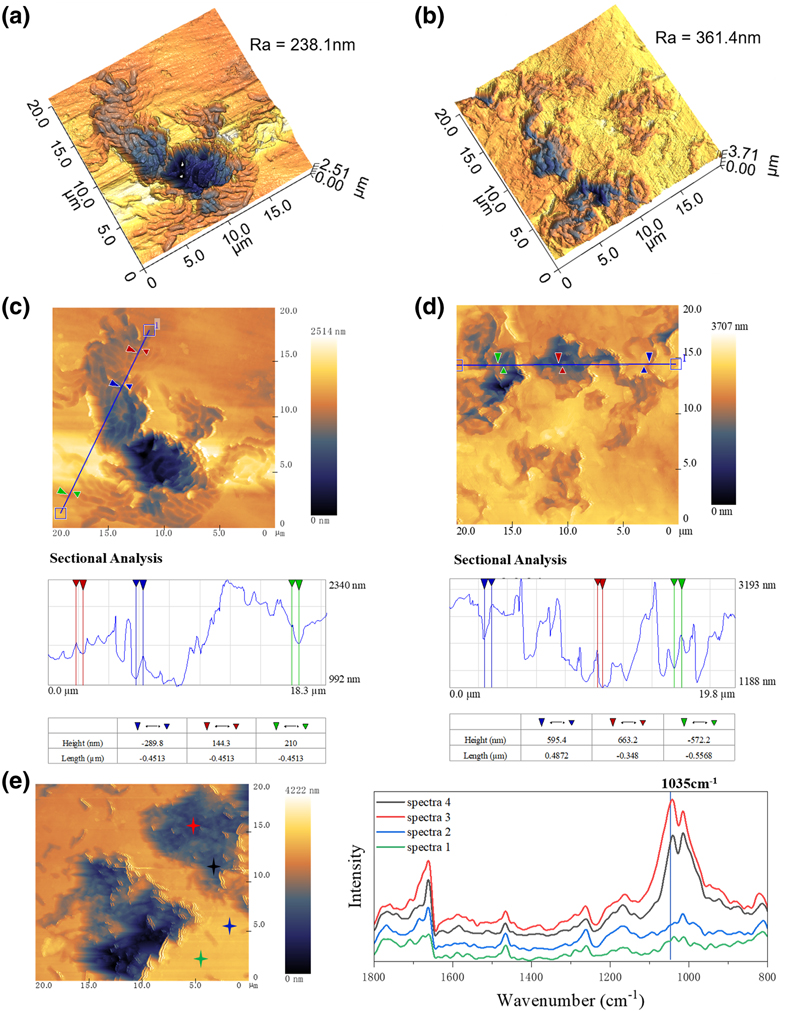
Figure 3 Typical examples of PiFM images, spectra, and sectional analysis of PE with corrosion pits. (a, b) 3D images of worm-like structures. Ra represents roughness average. (c, d) 2D images and the cross sectional analysis along the line. (e) PiFM images and spectra corresponding to inside of corrosion pits (spectra 3, 4) and outside of pits (spectra 1, 2).
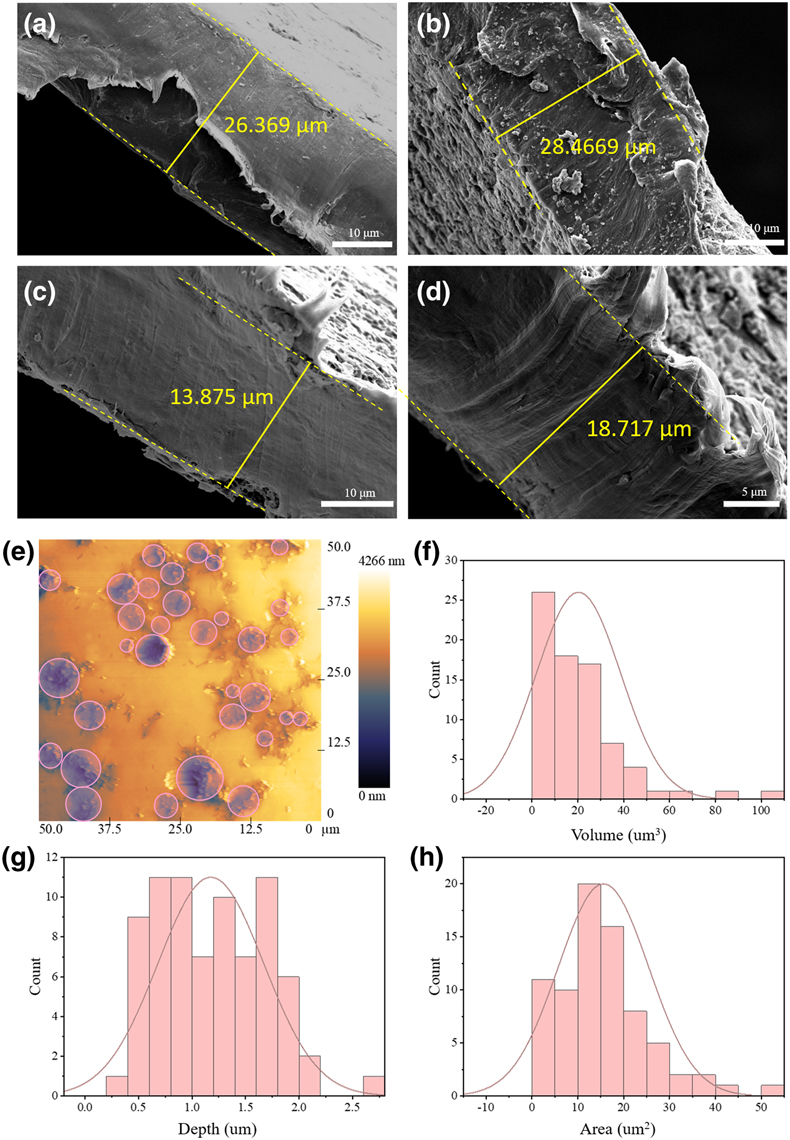
Figure 4 (a, b, c, d) Examples of SEM images of thickness of PE samples with corrosion pits. (e) PiFM image of P102. The circles in red were pits at least 1 μm wide and 0.1 μm deep. (f, g, h) Histogram of the depth, area and volume of corrosion pits of P102 measured by PiFM.


